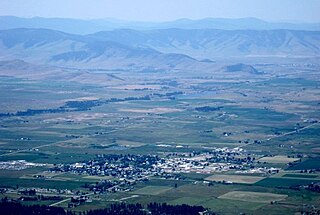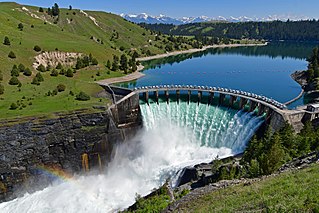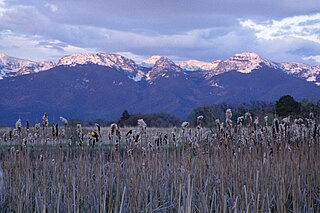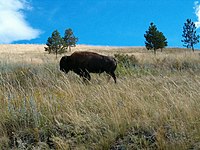
Charlo is an unincorporated community and census-designated place (CDP) in Lake County, Montana, United States. The population was 385 at the 2020 census.

Ravalli is an unincorporated community in Lake County, Montana, United States. The population was 76 at the 2010 census, down from 119 in 2000. For statistical purposes, the United States Census Bureau has defined Ravalli as a census-designated place (CDP). In the early 1900s, the Pablo-Allard herd in Ravalli was said to be the largest collection of the bison remaining in the U.S. and played a critical role in the conservation of bison.

Pablo is a census-designated place (CDP) in Lake County, Montana, United States. The population was 2,138 at the 2020 census. It is the home of Salish Kootenai College and the seat of government of the Flathead Indian Reservation.

Ronan is a city in Lake County, Montana, United States. It is on the Flathead Indian Reservation. The population was 1,955 at the 2020 census.

The Flathead Indian Reservation, located in western Montana on the Flathead River, is home to the Bitterroot Salish, Kootenai, and Pend d'Oreilles tribes – also known as the Confederated Salish and Kootenai Tribes of the Flathead Nation. The reservation was created through the July 16, 1855, Treaty of Hellgate.

The Confederated Salish and Kootenai Tribes of the Flathead Reservation are a federally recognized tribe in the U.S. state of Montana. The government includes members of several Bitterroot Salish, Kootenai and Pend d'Oreilles tribes and is centered on the Flathead Indian Reservation.

The Bitterroot Salish are a Salish-speaking group of Native Americans, and one of three tribes of the Confederated Salish and Kootenai Tribes of the Flathead Nation in Montana. The Flathead Reservation is home to the Kootenai and Pend d'Oreilles tribes also. Bitterroot Salish or Flathead originally lived in an area west of Billings, Montana extending to the continental divide in the west and south of Great Falls, Montana extending to the Montana-Wyoming border. From there they later moved west into the Bitterroot Valley. By request, a Catholic mission was built here in 1841. In 1891 they were forcibly moved to the Flathead Reservation.

The Pend d'Oreille or Pend d'Oreilles, also known as the Kalispel, are Indigenous peoples of the Northwest Plateau. Today many of them live in Montana and eastern Washington of the United States. The Kalispel peoples referred to their primary tribal range as Kaniksu.

The Seli’š Ksanka Qlispe’ Dam, also known as SKQ Dam, is a concrete gravity-arch dam located at river mile 72 of the Flathead River. Built in 1938, it raises the level and increases the size of Flathead Lake near Polson, Montana. The dam was designed to generate hydroelectricity but also serves recreational and irrigation uses.

Salish Kootenai College (SKC) is a private tribal land-grant community college in Pablo, Montana. It serves the Bitterroot Salish, Kootenai, and Pend d'Oreilles tribes. SKC's main campus is on the Flathead Reservation. There are three satellite locations in eastern Washington state, in Colville, Spokane, and Wellpinit. Approximately 1,207 students attend SKC. Although enrollment is not limited to Native American students, SKC's primary function is to serve the needs of Native American people.

Ninepipe National Wildlife Refuge is a 4,027-acre (1,630 ha) National Wildlife Refuge and unit of the National Bison Range Complex, located in Lake County, Montana.

Pablo National Wildlife Refuge is a National Wildlife Refuge of the United States located in northwestern Montana. It is a unit of the National Bison Range Complex of refuges. It is within the Flathead Indian Reservation, about 2 mi (3.2 km) south of Polson.
The Northwest Montana Wetland Management District is a wildlife management region in the U.S. state of Montana, a part of the National Bison Range Complex along with four other wildlife refuges and the National Bison Range.

The Salish or Séliš language, also known as Kalispel–Pend d'oreille, Kalispel–Spokane–Flathead, or Montana Salish to distinguish it from other Salishan languages, is a Salishan language spoken by about 64 elders of the Flathead Nation in north central Montana and of the Kalispel Indian Reservation in northeastern Washington state, and by another 50 elders of the Spokane Indian Reservation of Washington. As of 2012, Salish is "critically endangered" in Montana and Idaho according to UNESCO.
The Jocko River is a roughly 40-mile (64 km) tributary of the Flathead River in western Montana in the United States. It rises in the foothills of the Rocky Mountains and flows west into the Flathead at Dixon. The elevation is 2,503 feet (763 m) where it joins the Flathead. It is also known as Jacques Fork, Jim's Fork, Prune River or Wild Horse Creek. The river breaks into three forks, the North, Middle and South Forks, of which the Middle Fork is considered the main stem.
Corwin "Corky" Clairmont is a printmaker and conceptual and installation artist from the Confederated Salish and Kootenai Tribes of the Flathead Nation. Known for his high concept and politically charged works, Clairmont seeks to explore situations that affect Indian Country historically and in contemporary times.
I don't put work out that gives solutions but provokes questions. - Corky Clairmont
The National Bison Range herd of American bison in Flathead Valley of the U.S. state of Montana consisted of about 300-500 of these animals. The management was transferred from the U.S. Fish and Wildlife Service to the Confederated Salish and Kootenai Tribes in 2021. Other large wildlife found on the CSKT Bison Range include elk, white-tail and mule deer, pronghorn, bighorn sheep and black bear.

U.S. Highway 93 is a north–south United States Numbered Highway in the state of Montana.
The Wolakota Buffalo Range is a nearly 28,000-acre native grassland (11,000 ha) for a bison herd on the Rosebud Indian Reservation in South Dakota, home of the federally recognized Sicangu Oyate – also known as Sicangu Lakota, and the Rosebud Sioux Tribe, a branch of the Lakota people. The Rosebud Economic Development Corporation (REDCO), the economic arm of the Rosebud Sioux Tribe, is managing the land. Established in 2020, the herd will help develop ecological restoration, cultural practices, economic development, food security and public education. Wolakota involves public and private partners coming together in support of native-led efforts. Bison is the correct taxonomic term but buffalo is the common vernacular term. Buffalo continues to hold a lot of cultural significance, particularly for Indigenous people and is commonly used.

The conservation of bison in North America is an ongoing, diverse effort to bring American bison back from the brink of extinction. Plains bison, a subspecies, are a keystone species in the North American Great Plains. Bison are a species of conservation concern in part because they suffered a severe population bottleneck at the end of the 19th century. The near extinction of the species during the 1800s unraveled fundamental ties between bison, grassland ecosystems, and indigenous peoples’ cultures and livelihoods.# English speakers used the word buffalo for this animal when they arrived. Bison was used as the scientific term to distinguish them from the true buffalo. Buffalo is commonly used as it continues to hold cultural significance, particularly for Indigenous people. Recovery began in the late 1800s with a handful of individuals independently saving the last surviving bison.# Dedicated restoration efforts in the 1900s bolstered bison numbers though they still exist in mostly small and isolated populations. Expansion of the understanding of bison ecology and management is ongoing. The contemporary widespread, collaborative effort includes attention to heritage genetics and minimal cattle introgression.#






















